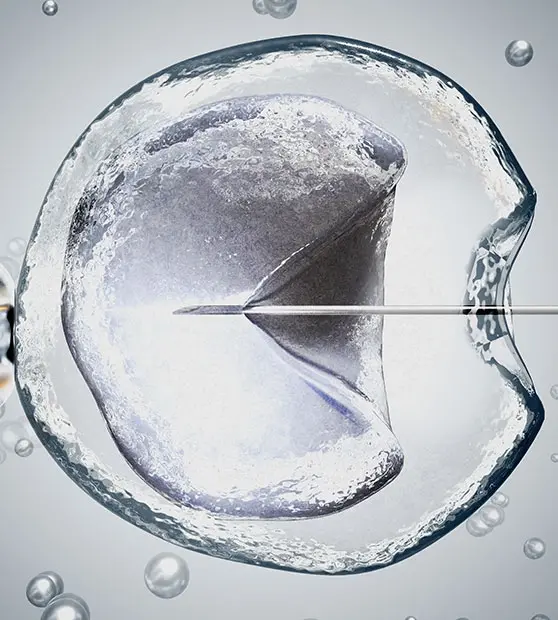What is IVF?
IVF or Invitro-fertilisation is the process of combining (fertilizing) the sperm and egg in a special laboratory environment to generate an embryo. The embryo is then carefully transferred into the uterus, its natural environment for development and growth, which culminates in the live birth of a baby. It is a ray of hope for childless couples. A combination of medicines and surgical procedures are used during IVF to help the sperm fertilize an egg. However, the chances of having a healthy baby depend on several things such as the age, general health, lifestyle of the couple as well as the cause of infertility.
How has IVF benefited people?
IVF has helped many people who would be otherwise unable to conceive. The ultimate benefit of IVF is achieving a successful pregnancy and a healthy baby. IVF has helped people in many ways and is suited for people with a number of conditions, hindering conception, such as:
PCOS: Polycystic ovary syndrome is a condition in which there is hormonal imbalance in the ovaries, which leads to lack of ability to release eggs regularly, making it difficult to achieve pregnancy. After having tried initial management, IVF is a valid treatment for women with PCOS, with high success rate.
Blocked tubes: With fallopian tubes blocked, there is no way egg and sperm can meet and fertilise. There is therefore no chance of conceiving naturally or even by treatments such as Intrauterine insemination. IVF provides the best chance of having a child for women with blocked or damaged fallopian tubes.
Male infertility: In male infertility, the main issue is low or no sperm available in the ejaculate, to fertilise the egg, ICSI (Intra-cytoplasmic sperm injection), an advanced version of IVF where a single sperm is needed to fertilise an egg. provides a great chance of conceiving for couples with male infertility problems.
Unexplained infertility:. One third of infertility is generally quoted to be of unexplained causes, where a clear cause of infertility cannot be identified. In reality, the proportion of true unexplained infertility is much smaller and a well-equipped fertility service with experienced and skilled doctors and embryologists will find causes not clear to the inexperienced. IVF, where a number of natural processes are bypassed, offers a good chance of success to couples with unexplained infertility.
Older women or women with a low ovarian reserve: It is an established fact that the number of eggs a woman has available for conceiving declines with age. Rarely, some women run out of eggs prematurely at younger age (Premature Ovarian Failure). IVF offers a good management strategy to these women by being able to either harvest a few eggs of their own or help using donated eggs to achieve pregnancy.
Endometriosis: Endometriosis is a disease where the parts of the womb lining grow outside the womb. Endometriosis may lead to poorer egg quality, blocked tubes, defective implantation, etc. Therefore, by using IVF it is possible to enhance the chances of conception by targeting management of impairment or defect of the reproductive function.
Is the adoption of IVF increasing?
There have been significant improvements and advancements in the latest ART techniques over the years, since the first successful IVF treatment in 1978. Success rates have consistently improved, while IVF treatments have become safer and safer. With changes in lifestyle and relationships, specially the delays in childbirth, IVF is gradually gaining prominence as an important discipline, despite being a relatively new branch of medical science.
Over the last 60 years, there is a visible move in the demographic trend of having children later. Women are delaying childbirth to later years, mainly due to pursuit of career ambitions. This change has been supported by higher education attainment amongst women, and their desire to prioritise career advancement in younger years, over having a family. Availability of safe contraception has helped women take control of their lives and no longer every sexual intercourse is at risk of ending in a pregnancy.
Advanced techniques in IVF such as egg harvesting and freezing is allowing women to delay childbirth, until a more suitable time in life, both professionally and relationship wise. Since quality of eggs and therefore chances of pregnancy decline with age, a lot of women today are helped by IVF to preserve their fertility in their younger years, for having a family successfully later in life. Since better quality eggs are harvested in younger years, the children born out of those eggs are healthier.
Challenges when going for IVF
New reproductive technologies, such as IVF, are becoming increasingly common, enabling infertile couples to become parents and create families. While serious complications from IVF medicines and procedures are rare, however there are some challenges that can happen.
Multiple births: If more than one embryo is transferred into the uterus, IVF increases the risk of multiple births which carries a higher risk of early labour and low birth weight than pregnancy with single foetus does.
Miscarriage and Ectopic pregnancy: The rate of miscarriage or ectopic pregnancy for women who conceive from IVF is higher to the rate of women who conceive naturally. It also depend on age, as older maternal age is also associated with a higher risk of miscarriage. This also includes health conditions which can possibly contribute to a higher risk of miscarriage.
Birth defects: No matter how the child is conceived, the age of the mother is the primary risk factor in the development of birth defects.
New techniques
Over the years, research focused on quest for increasing success rates and producing healthier children has led to development of new techniques with in the IVF. . Some of the technologies developed are:
Intracytoplasmic Sperm Injection (ICSI): This procedure focuses on male fertility. ICSI is required to help overcome fertilisation failures if the sperm count is low. . While in IVF, the eggs and sperm are kept in the petri dish, and the best sperm finds its way into the egg. In ICSI, under the vision of a high-powered special microscope, one sperm is injected into the egg using a specialized technique called micromanipulation. . This leads to increased chance of fertilisation.
Laser Assisted Hatching: The procedure of laser assisted hatching involves the use of a laser to break the thick wall around the egg, which prevents healthy embryos from implanting in the uterine wall. This allows the embryo to hatch and implant more easily into the lining of the uterus
Egg or Sperm freezing: Eggs and sperm are extracted from a woman and man to be frozen and used at a later date. This means that a couple delaying the decision to have children for health issues such as a serious illness like cancer, or for career related reasons, or a life-style related conscious decision etc. can still have biologically own children.. The technique can also be used for having a second baby through IVF.
Microscopic sperm extraction: This procedure is used to treat male infertility caused by the absence of sperm in the ejaculate of male partners. The sperms are directly surgically extracted from the testes. However, the use of special microscopes during the extraction increases the chance of success of finding sperm.
Preimplantation Genetic Testing (PGT): PGT of the embryo is carried out before implantation to ensure that the child to be born does not suffer from any genetic diseases in the future. PGT provides a safe platform for excluding risk of having a baby with genetic abnormality, reduces the risk of miscarriages (most miscarriages are caused by genetic abnormalities) and cuts the time to successful conception short.
IVF treatments have given many a couples and individuals a chance of having a family, which they otherwise would not have had a chance to have.
ART Fertility Clinics at the forefront of research and technology
Over the last 7 years ART Fertility Clinics has led the way globally in publishing high number of translational research papers. More than seventy papers have been published in high impact fertility journals, focusing on different aspects of IVF treatments, mainly
Individualisation of treatments by better understanding of human reproductive biology.
Raising awareness on simple lifestyle measures to reduce risk of fall in ovarian reserve.
Improving the chance of implantation of embryos in the uterus.
Use of genetic testing of embryos to improve chances of having a healthy baby and minimise risk of negative outcomes, including miscarriages.
In addition, ART fertility clinics uses most advanced technology in the embryology labs across all its clinics globally, maintaining highest quality and most stable environment for the growing embryos to give highest success rates –
Modular clean room IVF labs with airlock systems to maintain quality of air inside the embryology labs
In addition to HEPA filters, positive air pressure and activated carbon filters, using the Photo Catalytic Oxidation (PCO) technology to purify the air and reduce Volatile Organic Compounds (VOC) levels
RFID technology-based RI Witness system that allows traceability of gametes and embryos to avoid any mix up.
Alarm systems with sensors to continuously monitor the environment in the labs. Any deviation in temperature, humidity and gases, can be detrimental to outcomes.
Own genetic testing lab to make this crucial technology readily available to our clients at an affordable price.
ART Fertility clinics by keeping unwavering focus on delivering quality have consistently delivered amongst the highest success rates globally.



